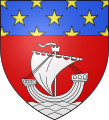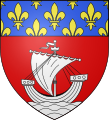Coat of arms of Paris
| Coat of arms of Paris | |
|---|---|
 | |
| Versions | |
 Escutcheon-only | |
| Other elements | Above the shield a mural crown Or |
The coat of arms of the city of Paris (French: Blason de Paris) shows a silver sailing ship on waves of the sea in a red field, with a chief showing the Royal emblem of gold-on-blue fleur-de-lis. Originally introduced in the 14th century, its current form dates to 1853. The city motto is Fluctuat nec mergitur ("[She] is tossed [by the waves], but does not sink"). The traditional colors of the city of Paris are red and blue.
History
The Marchands de l'eau (
When the French Revolution abolished the nobility by the decree of 20 June 1790, it simultaneously disallowed all emblems or coats of arms. The municipality of Paris quickly complied, and abolished its own arms in November of that same year.
It was not until the
The July Monarchy re-introduced the old (pre-revolutionary) coat of arms. Under the French Second Republic (1848–1852), the fleurs-de-lis were replaced by stars.
Under the
Additions made to the full achievement of the coat of arms in modern times include three badges, for:[3]
- the Legion of Honor(decree of 9 October 1900);
- the Croix de Guerre1914-1918 (Decree of 28 July 1919);
- the Order of Liberation (decree of 24 March 1945).
-
Seal of the marchands de l'eau, c. 1210 (SIGIL[LVM ME]RCATORVM AQVE PARISIVS)
-
Seal dated 1412, showing a ship with two fleur-de-lis [4]
-
Armorial de Gilles Le Bouvier (1455), representing the sailing boat (without sails) used by the marchands de l'eau.
-
16th-century depiction showing the chief semy of fleur-de-lis
-
Armorial of Paris under the First Empire
-
1844 depiction (July Monarchy)
-
Escutcheon of Paris under the Second Republic
-
1854 depiction with the mural crown and the motto but without the chief
-
1854 depiction with the mural crown and the chief but without the motto
-
Coat of arms of Paris in logo of 1924 Summer Olympics
-
Coat of arms according to the 1942 Commission d'héraldique urbaine de la Seine (Seine's department urban heraldic commission), approved by prefectoral decree of 20 June 1942
Motto

Fluctuat nec mergitur ("[she] is rocked [by the waves], but does not sink"; French: Il est agité par les vagues, mais ne sombre pas
The motto originates as an abbreviation of a longer Latin distich,
- Niteris incassum navem submergere Petri / Fluctuat at numquam mergitur illa ratis.
- "In vain you strive to submerge the ship of Peter— this vessel rocks but is never submerged."
This verse is medieval, attributed to either
The abbreviated verse first appears in connection with Paris, on coins (jetons), in the 1580s.[5] Before the 19th century, it was one of the mottoes associated with Paris, neither officially, nor exclusively. It was historically also associated with the city of Aimargues.[5]
Its official adoption as the motto of the city of Paris dates to 24 November 1853, in connection with the
The motto is part of the official livery of the Paris Fire Brigade. Following the November 2015 Paris attacks, the Latin-language motto had a surge in popularity and was used in social media as a symbol of Paris' resistance in the face of terrorism.
Contemporary use
The coat of arms is to be found on many Parisian
References
- ^ Faure, Juliet (2002). L'arsenal de Paris: histoire et chroniques (in French). L'Harmattan. p. 35.
- ISBN 2-7073-1054-9.
- ISBN 2-7384-6691-5.
- ^ Archives Nationales (Paris) Catalog number: D5585. Douët-d'Arcq, L. Collection de sceaux. Paris : H. Plon, 1863-1868.
- ^ a b c d Tausin, Henri (1914). Les devises des villes de France: leur origine, leur historique, avec les descriptions des armoiries [The mottos of French towns: their origins and history, with descriptions of their coats of arms] (in French). Paris: Éditions Honoré Champion. pp. 128–130.
- ^ "Paris". Archived from the original on 2022-10-22. Retrieved 2022-10-22.
- ^ The verse is edited in: Hans Walter, Carmina Medii Aevi Posterioris Latina II/3 (1965), p. 170. See also: Giotto and the World of Early Italian Art (1998), p. 357. Helmtrud Köhren-Jansen, Giottos Navicella (1993) p. 264. Anastase Cochelet, Response à l'abiuration de la vraie foy, que font les Caluinistes, qui apostatent de l'Église Catholique, Apostolique, Romaine: fausement appellée, par eux, Declaration Chrestienne (1604), p. 170
- ^ Bodleian MS. Ashmole 1437 (15th century): Catalogi codicum manuscriptorum bibliothecae Bodleianae vol. 10 (1845), c. 1179.
- ^ Matthias Flacius, Clavis Scripturae Sacrae (1567) s.v. "navis": Navicula Christi a S. Patribus declaratur, quod sit typus Ecclesiae perpetuo periclitantis, sed nunquam prorsus pereuntis, iuxta versum: Fluctuat, at nunquam mergitur illa navis.
- ^ An early example dated 1854 is a print by Charles Méryon (1821–1868) kept by the Metropolitan Museum of Art (accession number 17.21.37).
Further reading
- Marc Declerck, Les armoiries de Paris, L'Harmattan, 2007 (ISBN 2296025471)
- A. Coëtlogon, M.-L. Tisserand, "Les devises de la ville de Paris", Les Armoires de la Ville de Paris (1874), 180–189.
External links
 Media related to Coats of arms of Paris at Wikimedia Commons
Media related to Coats of arms of Paris at Wikimedia Commons

![Seal of the marchands de l'eau, c. 1210 (SIGIL[LVM ME]RCATORVM AQVE PARISIVS)](http://upload.wikimedia.org/wikipedia/commons/thumb/7/73/Moulage_du_sceau_des_marchands_de_l%27eau_de_Paris._1_-_Archives_Nationales_-_SC-D5582.jpg/120px-Moulage_du_sceau_des_marchands_de_l%27eau_de_Paris._1_-_Archives_Nationales_-_SC-D5582.jpg)
![Seal dated 1412, showing a ship with two fleur-de-lis [4]](http://upload.wikimedia.org/wikipedia/commons/thumb/7/70/Seal_of_Paris_%28No_6%29.jpg/120px-Seal_of_Paris_%28No_6%29.jpg)








